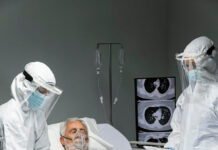In today’s digital age, healthcare organizations face a multitude of cybersecurity challenges due to the increasing complexity of IT networks and the valuable data they possess. Just like businesses in other sectors, healthcare entities are prime targets for cyber threat actors seeking to exploit vulnerabilities in their systems. Amidst the overwhelming volume of security data and the diverse array of IT solutions to monitor and protect, healthcare security teams often find themselves stretched thin. Compounding the issue is the complexity of managing numerous point security products, further complicating security efforts. Ruchin Kumar, VP- South Asia of Futurex, a security platform, helps us understand the integration of various security functionalities and centralized monitoring and how to streamline security operations against evolving threats.
The Indian Practitioner (TIP): What are the most common vulnerabilities in IoT devices used in healthcare, and how can these vulnerabilities be addressed?
Ruchin Kumar: Common vulnerabilities in healthcare IoT devices include weak encryption, insufficient authentication measures, outdated software, insecure interfaces, lax access controls, physical security vulnerabilities, and concerns regarding data privacy. Addressing these vulnerabilities requires the adoption of innovative solutions. One approach is to enhance encryption protocols to protect sensitive patient data from unauthorized access and tampering. This involves implementing cutting-edge encryption technologies to establish robust encryption standards. Additionally, improving authenti- cation mechanisms is crucial for mitigating the risk of unauthorized access to IoT devices. Utilizing advanced authentication solutions and hardware-based cryptographic keys can bolster authentication processes. Implementing stringent access controls is also essential to restrict access to sensitive functionalities and data to authorized personnel only. This can be achieved through the enforcement of role-based access control and least privilege principles. Furthermore, ensuring compliance with data privacy regulations such as GDPR and HIPAA is imperative. This involves expertise in regulatory requirements to avoid costly fines and reputational damage associated with non-compliance.
TIP: How can healthcare providers establish a robust authentica-tion and access control system for IoT devices to prevent unau-thorized access?
RK: Certainly, establishing robust authentication and access control for IoT devices in healthcare is imperative to safeguard sensitive patient data and ensure the integrity of medical operations. To achieve this, health-care providers employ a multifaceted approach: Firstly, we implement stringent authentication measures, including strong, unique passwords and multi-factor authentication, to verify users’ identities when accessing IoT devices. This helps mitigate the risk of unauthorized access. Secondly, we utilize role-based access control (RBAC) to assign specific permissions based on users’ roles and responsibilities. By adhering to the principle of least privilege, we ensure that users only have access to the functionalities and data necessary for their tasks. Thirdly, we leverage centralized identity management systems to efficiently manage user accounts, permissions, and authentication credentials across all IoT devices. This facilitates streamlined access control processes and enhances security posture. Furthermore, device authentication through certificates or secure keys is enforced, along with strict password policies and periodic updates. Users are educated on security best practices to safeguard credentials properly. By leveraging Futurex’s state-of-the-art encryption technologies and identity management systems, healthcare providers can enhance device authentication processes, mitigating the risk of unauthorized access to IoT devices.
TIP: What strategies can healthcare organizations use to regularly update and patch IoT devices to protect against emerging security threats?
RK: Healthcare organizations implement various strategies to ensure the regular updating and patching of IoT devices. They establish comprehensive patch management policies and outline procedures for identifying, testing, and deploying patches across all devices. Maintaining an up-to-date inventory of devices is crucial for efficient tracking and prioritization of patch deployment. Automated patching systems streamline the process, scheduling and deploying patches automatically to minimize delays and errors. Collaboration with vendors is essential for staying informed about security vulnerabilities and upcoming patches and facilitating timely delivery. Segmenting IoT networks isolates devices from critical systems, while continuous monitoring tools detect anomalies or suspicious activities. Testing patches in controlled environments before deployment ensures compatibility and stability. Fallback mechanisms provide a safety net in case of unexpected issues post-deployment. Employee training on patching procedures enhances awareness and prompt reporting of security concerns. Finally, ensuring compliance with regulations and standards such as HIPAA and HITRUST is essential for maintaining security and data integrity.
TIP: How can healthcare providers monitor the network traffic generated by IoT devices to detect and respond to suspicious or malicious activities?
RK: Healthcare providers are increasingly vigilant in monitoring network traffic from IoT devices to detect and respond to potential security threats effectively. This involves employing techniques such as network traffic analysis, intrusion detection systems, packet inspection, flow analysis, behavioral analysis, anomaly detection, and threat intelligence integration. By analyzing network traffic patterns and behaviors, healthcare organizations can identify anomalous activities that may indicate malicious intent, such as malware in- fections or unauthorized access attempts. Additionally, endpoint detection and response solutions deployed on IoT devices enable monitoring and analysis of device-level activities, complementing network-based monitoring efforts. Regular log monitoring and analysis provide valuable insights into network traffic, facilitating the correlation of events across different devices and systems. Incident response planning is crucial for healthcare providers to ensure readiness in addressing security incidents promptly and effectively. Healthcare organizations can bolster their cybersecurity defenses and protect sensitive patient data from potential cyberthreats by implementing robust monitoring techniques and incident response protocols.
TIP: How can healthcare organizations create a secure and isolated network segment for IoT devices to minimize the potential for lateral attacks?
RK: Healthcare organizations can establish a secure and isolated network segment dedicated to IoT devices to mitigate the risk of lateral attacks. This involves dividing the network into separate segments and allocating one specifically for IoT devices. By implementing Virtual LANs (VLANs), healthcare providers can logically separate IoT devices from other network resources, controlling traffic flow and restricting communication between IoT devices and critical systems. Additionally, deploying firewalls and Access Control Lists (ACLs) enables organizations to enforce traffic filtering rules, allowing only necessary communication and blocking unauthorized access attempts. Intrusion Detection and Prevention Systems (IDPS) can enhance security by monitoring traffic entering and leaving the IoT network segment and detecting and preventing suspicious activities. Network Access Control (NAC) solutions authenticate and authorize devices before granting access, ensuring that only authorized and properly configured IoT devices can connect to the network. Employing encryption protocols such as TLS or VPNs protects data transmitted within the IoT network segment, guarding against eavesdropping and interception. Regular monitoring, auditing, and employee training on IoT security practices help maintain the integrity of the network segment and ensure resilience against evolving threats. By implementing these measures, healthcare organizations can create a robust de- fense against lateral attacks and safeguard critical infrastructure and patient data. With Futurex solutions, healthcare organizations can encrypt data transmitted between IoT devices and network endpoints, ensuring protection against eaves-dropping and data interception. Futurex offers robust encryption protocols, which can be utilized to secure communication channels within the IoT network segment effectively. By integrating Futurex’s encryption technologies, healthcare providers can establish secure communication pathways that safeguard sensitive data and uphold patient privacy.
TIP: How can healthcare organizations prepare for and respond to security incidents involving IoT devices to minimize the impact on patient care and privacy?
RK: Healthcare organizations can minimize the impact of security incidents involving IoT devices on patient care and privacy by implementing comprehensive strategies. Firstly, they should develop a detailed incident response plan to address such incidents, outlining roles, procedures, and escalation paths. Regular training programs should be provided to educate staff on recognizing and responding to security breaches, emphasizing security best practices and incident reporting protocols. Real-time monitoring systems can con- tinuously monitor IoT device activity and network traffic, with intrusion detection and prevention systems in place to detect and block malicious activities promptly. Additionally, encrypting sensitive data transmitted between IoT devices and network endpoints ensures patient privacy and prevents unauthorized access. Robust access controls and authentication mechanisms restrict access to IoT devices and sensitive data, while proactive patch management processes ensure devices are regularly updated with the latest security fixes. Healthcare organizations should designate an incident response team comprising various stakeholders to coordinate responses effectively and conduct thorough forensic analysis following security incidents. Collaboration with external cybersecurity experts and regulatory authorities is essential for sharing information and complying with reporting requirements. Finally, continuous improvement through post-incident reviews and lessons learned exercises help enhance overall cybersecurity posture and resilience against future threats.
TIP: Are there specific security challenges or considerations for wearable health devices and remote patient monitoring systems, and how can these be addressed?
RK: Wearable health devices and remote patient monitoring systems present distinct security challenges that healthcare organizations must address to safeguard patient data privacy and security. These devices collect sensitive health data, necessitating stringent measures to ensure confidentiality and integrity. Authentication mechanisms and access controls must be robust to verify user identities and restrict unauthorized access to patient data. Secure communication channels between devices and healthcare networks are essential to prevent data interception or tampering during transmission. Additionally, device security measures, including encryption and regular firmware updates, are crucial to protect against physical and cyber threats. Compliance with regulations such as HIPAA or GDPR is mandatory to maintain legal and ethical standards in handling patient data. By implementing encryption, authentication, secure communication protocols, device manage- ment solutions, regular security audits, and user education initiatives, healthcare organizations can effectively mitigate the security risks associated with wearable health devices and remote patient monitoring systems, ensuring the confidentiality and integrity of patient data across the healthcare continuum. Futurex solutions offer comprehensive capabilities in encryption, authentication, secure communication protocols, device management, regular security audits, and user education initiatives. By integrating Futurex solutions, healthcare organizations can effectively mitigate the security risks associated with wearable health devices and remote patient monitoring systems, ensuring the confidentiality and integrity of patient data across the healthcare continuum.
TIP: Could you explain how Futurex’s Hardware Security Modules (HSMs) contribute to securing sensitive data at rest or in transit?
RK: A hardware security module (HSM) is a physically and logically secure device that performs cryptographic functions. Futurex HSMs use logical security features like dual-login controls and permissions management. They ensure physical security with tamper-resistant enamel casings, which protect the encryption components on the HSM’s circuit board. These physical security features also allow organizations to store encryption keys in a way that neutralizes the concern of exposure or breach. Furthermore, Futurex HSMs integrate with many business applications to perform encryption and manage their encryption keys. In other words, our HSMs use strong cryptography to meet data security needs of any type and scale.
TIP: How has Futurex adapted to the evolving digitalization and data security landscape over its 40-year history?
RK: Thanks to our longevity, we’ve observed the industry’s evolution from within, making us particularly effective at anticipating emerging trends. Being familiar with the market allows us to provide genuinely cutting-edge solutions to our customers. For example, we were the first to offer HSM virtualization through our Vectera product line—an innovation that other cryptography providers soon imitated. We were also the first to provide a truly global cloud HSM platform. We accomplished this by establishing data centers in every geographic region, providing customers with high availability and low latency no matter their location.
TIP: In what ways does Futurex inspire confidence in organizations looking to embrace digitalization without compromising sensitive data security?
RK: When it comes to data security, there’s no better symbol of trust than a certification with a high standard of compliance. To pass that trust onto our customers, we ensure our solutions are validated under PCI HSM, PCI PIN, FIPS 140-2 Level 3, and many other widely recognized security standards. As a result, our customers enjoy the peace of mind that comes from using a trusted vendor that prioritizes compliance.
TIP: What are Futurex’s plans for the Indian market?
RK: Futurex is firmly committed to the Indian market. As a payment processing hub and global fintech capital, there is an excellent demand for robust datasecurity solutions. In addition to partnering with key IT distributors and consultants, we’ve established data centers in Hyderabad and Mumbai. Having a local data center presence allows us to offer low latency, high availability, and effortless data localization compliance to customers throughout the Indian market. However, that’s just the beginning—we eagerly anticipate the future as the market advances. compliance.


Dr. Soham Bhaduri, our Executive Editor steps down Our Executive Editor, since the last six years and more, has stepped down effective from end March’24. Dr. Bhaduri brought in a high degree of professionalism in all aspects of editing, rigorous standards for accepting and reviewing articles, as well as ensuring that peer reviewing was up to well laid down standards. His inputs over the years have helped The Indian Practitioner develop into a medical journal with well benchmarked editorial content quality. His meticulous scrutiny, overall guidelines and suggestions have helped The Indian Practitioner reach a far higher level that it is today. We express our deep appreciation and gratitude to him for his editorial services. Dr. Bhaduri continues as a member of The Indian Practitioner, Editorial Board.
Vinoo Mathews
CEO


























